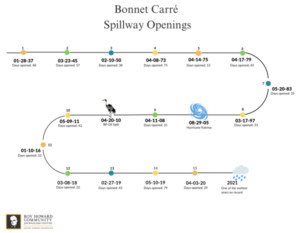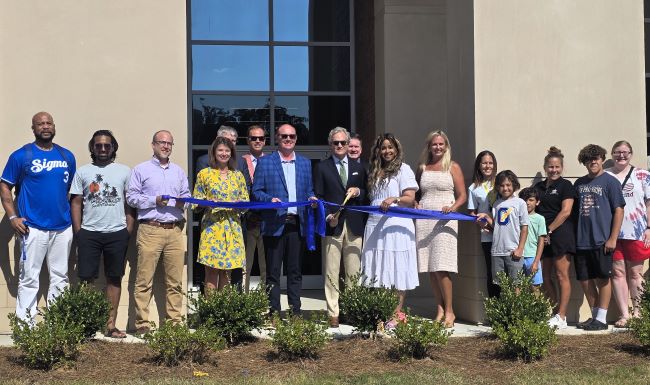Oyster season is back, but for how long?
Published 2:14 pm Wednesday, January 15, 2025

- An officer with the Mississippi Department of Marine Resources checked oysters on a boat at the Pass Christian Harbor. (Justin Glowacki)
Roy Howard Community Journalism Center
Trending
2024 marked the return of oyster season on the Mississippi Gulf Coast for the first time in six years.

Patrick Parkinson recounts how oyster fishing in Mississippi has changed over the years. (Justin Glowacki)
For fishermen like Patrick Parkinson, this season marks a return to a way of life that environmental challenges halted for six years in the Mississippi Sound.
“This is the first time in like 14 years I’ve been oystering here in the Mississippi Sound,” Parkinson said. “It’s been perfect — plenty of oysters, perfect eating oysters, real salty … not too much freshwater because the spillway has been closed for so long.”
While this season is a welcome change, the industry remains in a precarious state. Fishermen and marine scientists alike are optimistic but know a single event — such as the opening of the Bonnet Carré Spillway — could undo years of recovery.
A fragile recovery
Mississippi’s oyster industry has faced decades of setbacks — from the devastation of Hurricane Katrina in 2005 to the Deepwater Horizon oil spill in 2010. These disasters not only destroyed oyster reefs but also hurt the local economy.

Seafood landing statistics — sourced from the Mississippi State University National Strategic Planning and Analysis Center (Social Impacts of the 2019 Bonnet Carré Spillway Disaster: A Baseline).
Trending
One of the biggest challenges in recent years has involved the Bonnet Carré Spillway, a flood control structure that protects levees in southern Louisiana by diverting water from the Mississippi River into Lake Pontchartrain and the Mississippi Sound.
“When you bring in polluted water from 31 states and two provinces in Canada, and push it in large quantities, it disrupts the ecosystem,” said Dr. Moby Solangi, director of the Institute for Marine Mammal Studies.
“Every time they’ve opened (the spillway), we’ve had major kills in fisheries, oysters dying, shrimp dying and dolphins.”
“It was hard to come back. We lost all of our spawning stock, bottom mass. But as conditions have improved, we have seen, the resiliency of the population as it started to build back,” added Rick Burris, chief scientific officer at the Mississippi Department of Marine Resources.
A precarious future
For now, the Mississippi Sound is starting to rebound, and local oystermen are savoring the success of the 2024 season. But, as Parkinson and others know, the future remains uncertain.
“It depends on if we have floods up north for the Ohio River Valley. If it starts flooding — everything — (and we’re) about to break the levee, then we’ll be stuck opening up the spillway,” Parkinson said. “We might have to go back through the whole rotation with our oysters.”

An officer with the Mississippi Department of Marine Resources checked oysters on a boat at the Pass Christian Harbor. (Justin Glowacki)
While ongoing restoration efforts have begun to show promise, the possibility of future spillway openings continues to threaten the millions of dollars invested in restoring the Mississippi Sound.
“I’ve been a part of several of these openings going back to 2008,” Burris said. “And we’ve seen some significant damage — 2011 and 2019 especially. But the 2019 (opening) really took a toll on not just the oyster reefs, but, you know, a lot of the ecosystem in the western Mississippi Sound, and it reached all the way to the eastern Mississippi Sound.”
The U.S. Army Corps of Engineers operates the spillway. They currently use operating procedures from when the spillway was built nearly 100 years ago. They are currently conducting a study re-evaluating the procedures they are using.
For Solangi, this is a long time coming: “I mean, how many of us drive a 1927 car? No, I mean, as times change, you have to adjust. A lot of things have changed.”
Based on the results of the study, the USACE says they may revise their standards for operating the spillway. However, if the findings suggest what they are currently doing is safer for communities south of the levees, they will continue to open the Bonnet Carré Spillway and maintain their current practices.
The spillway was last opened in 2020 for 28 days following heavy rains along the Mississippi River. Outside of spillway operations, Burris noted that 2021 brought one of the wettest years on record for Mississippi — with freshwater levels in the Sound rivaling those seen during the 2019 spillway opening.
“We had a little bit of setback there. But the past couple of years have been very good to us,” Burris explained.
Since 2021, drier conditions have provided a window for the MDMR to accelerate restoration efforts and rebuild oyster reefs without interruption.
State support
Parkinson credits the return of the oyster season to the MDMR and other local organizations who have helped rebuild the ecosystem.
“The growth is really coming back from putting out oyster shells and everything,” he said. “The DMR, everybody, is putting it all back together with the reefs. We’re getting really serious.”
The MDMR has been working on restoration projects to ensure the long-term viability of the Sound’s oyster reefs since the inception of the program in 1994. Burris highlighted some of the restoration efforts his department has taken on since oyster season closed following the 2019 spillway opening.
“We’ve been doing a lot of cultch plants, which have been highly successful … especially after the past couple of years,” he said. “We’ve had really good environmental conditions with pretty good spats, especially last year. So, we’ve seen some good results out of that.”
Other restoration efforts to repopulate the oyster population allow oysters to grow in controlled environments, making them less vulnerable to environmental shocks.
“It kind of takes Mother Nature out of the equation and lets us set the size oysters we want,” Burris said.
One of the MDMR’s newer initiatives focuses on leasing oyster reefs to private companies. Rather than relying solely on the state to rebuild what was lost, the plan allows private interest groups to take over sections of the Sound and work collaboratively to restore the reefs. The goal is to accelerate restoration and create a healthier Mississippi Sound.
“We feel like with the private interest of those groups, they’ll be able to restore those areas quicker than we could because we lost thousands of acres of oysters, and it’s a very costly endeavor to rebuild those all back at once, by the state,” Burris said.
“If we can work with the private industry, with the reefs we have available, and we’re able to get a majority of the historical footprint of Mississippi’s oyster reef, especially in the western Mississippi Sound with, with cultch on the bottom, oysters growing on it,” he added.

Private leasing has a proven track record of success. In Louisiana, fishermen hold leases on around 400,000 acres of reefs while the state maintains 1.7 million acres. According to the Biloxi Sun Herald, Louisiana oyster reefs just 10 miles across the Mississippi-Louisiana state line were producing oysters while Mississippi was still trying to recover their reefs in 2023.
“It’s a much better environment (in Louisiana). But they do have private industry involved and their private industry does a good job of restoring their reefs, harvesting sustainably, and the Louisiana oyster industry is thriving,” Burris said.
With collaboration between private industry and state efforts, Burris hopes to see broader effects of the partnerships.
“And (if) we’re able to get those thriving oyster reefs back, that good population, you’re going to see a significant increase, not just in oyster harvest, but you’re going to see a significant increase in the ecosystem in general,” he said. “All your fish, most of your inshore fish species, your shrimp, your crabs, all your entire invertebrates, they all come to these oyster reefs to spawn, they come to these oyster reefs to feed, they come to oyster reefs for refuge.”
Fishermen, however, have a different perspective. At the Dec. 17, 2024, meeting of the Mississippi Advisory Commission on Marine Resources, commercial fishermen from across the Mississippi Coast gathered to express their concerns about the decision to lease the reefs.
They argued that the reefs struggled in the past but always managed to recover. By leasing them to private companies, they believe the MDMR is abandoning the hard work and taxpayer investment that went into restoring the reefs under state control.
The Roy Howard Community Journalism Center will explore this debate in a separate story.
Mississippi’s resiliency in the face of challenges
Despite the threat of another spillway opening, Mississippi’s fishing communities continue to build the oyster industry back up.
“There’s been a series of man-made and natural disasters that have completely devastated the oyster reefs, and as I mentioned, we’re seeing resiliency. We’re seeing the ecosystem come back, and we’re seeing, you know, kind of on the same level, the fishery come back,” Burris said.

The Royster docked at the Pass Christian Harbor. (Justin Glowacki)
Burris also expressed optimism that the U.S. Army Corps of Engineers might find alternative solutions for spillway operations.
“Hopefully, we’ll come up with some ways to try to do things a little differently in the future,” he said.
With continued investment, studies and cooperation, the hope is not just to restore the oyster industry but to rebuild the entire ecosystem it supports.
For the oystermen, the 2024 season is more than a victory — it’s a critical step toward a sustainable future.





